
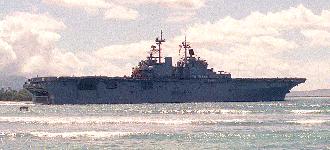
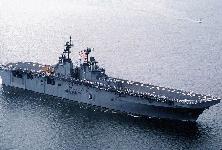


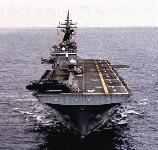
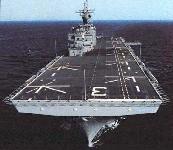


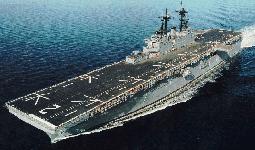
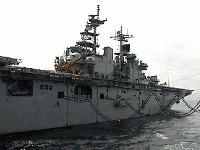

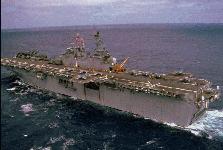
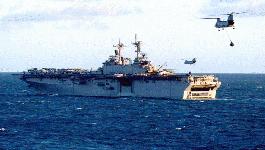
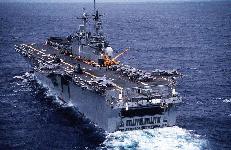
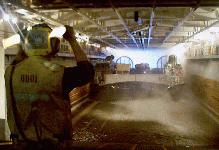
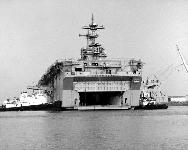
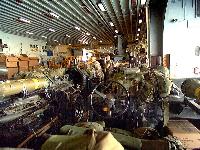
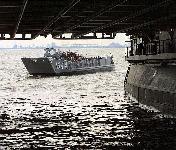
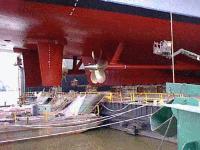







 The Wasp-class are the largest amphibious ships in the world. The LHD is an improved follow-on to the five ship Tarawa-class LHAs, sharing the basic hull and engineering plant. The LHD l has an enhanced well deck, enabling it to carry three LCACs (vice one LCAC in the LHAs). The flight deck and elevator scheme is also improved, which allows the ship to carry two more helicopters than its predecessor, the LHA.
Ships of the LHD 1 multipurpose amphibious assault ship program are named for famous U.S. Navy warships which themselves were not named for battles. In naming LHD 1 "WASP," the Navy honors nine previous ships, dating to the American Revolution, which have borne this illustration name. In February 1984, Ingalls Shipbuilding in Pascagoula, Miss., was awarded the contract to build the lead ship of the LHD 1 class, USS Wasp, which was commissioned
June 24, 1989 in Norfolk, Virginia. The second LHD was awarded in
September 1986 in a competitive bid, also to Ingalls, as a single
ship with options, which were awarded in 1988 and 1989. In December 1991, Ingalls won a major competition to build a fifth LHD. That contract included an option exercised with Ingalls in December 1992 for the construction of LHD 6, and an option exercised in December 1995 for
the construction of LHD 7. LHDs beyond number five will go toward replacing the aging LPHs which will reach the end of their service lives from the mid 1990s on. Construction of the ships of the class continues at Ingalls Shipbuilding, Pascagoula, Miss.
WASP class ships are the first to be specifically designed to accomidate the AV-8B
Harrier jump jet and the LCAC hovercraft, along with the full range of Navy and Marine helicopters, conventional landing craft and amphibious assault vehicles to support a Marine Expeditionary Unit (MEU) of 2,000 Marines. The ships also carry some of the most sophisticated communications, command and control capabilities afloat, alongwith state of the art electronic systems and defensive weaponry.
The Wasp-class are the largest amphibious ships in the world. The LHD is an improved follow-on to the five ship Tarawa-class LHAs, sharing the basic hull and engineering plant. The LHD l has an enhanced well deck, enabling it to carry three LCACs (vice one LCAC in the LHAs). The flight deck and elevator scheme is also improved, which allows the ship to carry two more helicopters than its predecessor, the LHA.
Ships of the LHD 1 multipurpose amphibious assault ship program are named for famous U.S. Navy warships which themselves were not named for battles. In naming LHD 1 "WASP," the Navy honors nine previous ships, dating to the American Revolution, which have borne this illustration name. In February 1984, Ingalls Shipbuilding in Pascagoula, Miss., was awarded the contract to build the lead ship of the LHD 1 class, USS Wasp, which was commissioned
June 24, 1989 in Norfolk, Virginia. The second LHD was awarded in
September 1986 in a competitive bid, also to Ingalls, as a single
ship with options, which were awarded in 1988 and 1989. In December 1991, Ingalls won a major competition to build a fifth LHD. That contract included an option exercised with Ingalls in December 1992 for the construction of LHD 6, and an option exercised in December 1995 for
the construction of LHD 7. LHDs beyond number five will go toward replacing the aging LPHs which will reach the end of their service lives from the mid 1990s on. Construction of the ships of the class continues at Ingalls Shipbuilding, Pascagoula, Miss.
WASP class ships are the first to be specifically designed to accomidate the AV-8B
Harrier jump jet and the LCAC hovercraft, along with the full range of Navy and Marine helicopters, conventional landing craft and amphibious assault vehicles to support a Marine Expeditionary Unit (MEU) of 2,000 Marines. The ships also carry some of the most sophisticated communications, command and control capabilities afloat, alongwith state of the art electronic systems and defensive weaponry.
WASP class ships are 844 feet long with a beam of 106 feet. Two steam propulsion plants, the largest in the Navy, develop 70,000 shaft horsepower for each of the two propulsion shafts. These plants allow the 40,500 ton ship to reach speeds greater than 20 knots. The ship's two propulsion plants generate a total of 400 tons of steam per hour. If the energy of the two boilers were converted to electrical power, it could power a city of 160,000. Electrictal generators aboard ship provide more than 16,000 kilowatts of power for shipboard systems. Two pumping stations give KEARSARGE a 450,000 gallon fueling capacity for embarked aircraft and other vehicles. Onboard distilling plants provide up to 200,000 gallons of fresh water each day. Each WASP class ship has accommodations for 3,000 troops and crew members. Ships crew consists of 98 officers and 983 enlisted personnel. The ships have six fully equipped operating rooms and a 600 bed hospital, by far the largest at sea with the exception of hospital ships.
These ships conduct prompt, sustained combat operations at sea as the centerpiece of the Navy's amphibious strategy of "Forward ... From the Sea." They provide the means to deliver, command and support all elements of a Marine Landing Force in an assault by air and amphibious craft. In carrying out their mission, the ships have the option of utilizing various combinations of helicopters, Harrier II (AV-8B) Jump Jets and air cushion landing craft (LCAC), as well as conventional landing craft and assault vehicles, illustrating the LHD's flexibility. Off the landing beach, Boxer can ballast more than 15,000 tons of seawater for trimming during landing craft launch and recovery operations in the well deck.
WASP-class ships can also provide command and control and aircraft facilities for sea control missions, while operating with an aircraft carrier battle group. They transport and land ashore not only troops, but also the tanks, trucks, jeeps, other vehicles, artillery, ammunition and various supplies necessary to support the amphibious assault mission. Monorail trains, moving at speeds up to 600 feet per minute, transport cargo and supplies from storage and staging areas throughout the ship to a 13,600 square foot well deck which opens to the sea through huge gates in the ship's stern. There, the cargo, troops and vehicles are loaded aboard landing craft for transit to the beach. Air cushion landing craft can "fly" out of the dry well deck; or the well deck can be ballasted down for conventional craft to float out on their way to the assault area. Helicopter flights also transfer troops and equipment to the beach, while the ship's air traffic control capability simultaneously directs close air tactical support provided by embarked jet aircraft and helicopter gunships.Although the ships are capable of embarking two LCU's this configuration is not recommended to be used for deployment planning due to the requirement to lash, block, and shore LCU's in accordance with current wet well procedures. During an administrative onload, two LCU's can be embarked and offloaded with proper planning considerations. Only pax and cargo (4K forklift and monorail) operations can be conducted when two LCU's are brought far enough into the well to close the stern gate. To conduct simultaneous vehicle operations with two LCU's, the second LCU must extend out of the well. The ships can can carry up to 61 Amphibious Assault Vehicles (Landing Vehicle Tracked Personnel LVTP-7), with 21 stowed in upper vehicle stowage and 40 stowed in the well deck.
Fabrication work for BATAAN (LHD-5) began at the Ingalls Shipbuilding facility on August 2, 1993, and the ship's keel was laid on March 16, 1994. LHD-5 was launched on March 15, 1996. BATAAN was built utilizing efficient preoutfitting and modular construction techniques. Hundreds of smaller subassemblies, in which piping sections, ventilation ducting and other shipboard hardware, as well as major machinery items, such as main propulsion equipment, generators, and electrical panels were constructed. The preoutfitted subassemblies were then joined with others to form assemblies which were welded together to form five completed hull and superstructure modules. These five giant ship modules, each weighing thousands of tons, were joined together on land to form the completed ship's hull prior to launch. The result of this early outfitting and modular construction was a ship 74 percent complete at launch. The ship's launching was just as innovative as her construction. LHD-5 was rolled from her construction area to a floating drydock for launch on a rail transfer system. The drydock was then positioned over a deep-water pit and ballasted down, allowing LHD-5 to float free.LHD-5 is the Navy's first amphibious assault ship designed and built from the keel up with accommodations for female sailors. This "Women at Sea" modification provides LHD-5 with living areas for nearly 450 female officers, chiefs, enlisted personnel and embarked troops. Overall, the ship has living areas for nearly 3,200 crew members and troops.
Funding for the LHD-6 was provided in two stages in fiscal year 1993 and in fiscal year 1994. In 1993, at the initiative of the Appropriations Committee, the Congress appropriated $50 million to initiate advanced funding for the LHD-7. The conferees of the defense appropriations bill noted that they expected the Navy to request funds in fiscal year 1995 for the balance of the ship before the Navy obligated the $50 million appropriated. However, instead of requesting the additional funds, the Navy sought to rescind $50 million from this appropriations. The Defense Department reviewed this issue in its fiscal year 1995 budget and determined that it could not afford to purchase the LHD-7 in fiscal year 1995. It argued that 11 large deck carriers fulfill 96 percent of the forward presence requirements of the Navy and Marine Corps. It also noted that the first LHA ship will not need to be retired until the year 2011, and therefore the Department recommended that the Navy and Marines wait until the turn of the century to build the LHD-7. The Secretary of Defense and the Joint Chiefs of Staff determined that sealift ships were a higher priority, and the President's fiscal year 1995 budget requests reflected this priority--it requested funds for sealift, and did request funds for the LHD-7. Proponents argued that the the contract option on LHD-7 would expire in December 1994, and that if the contract option expired and the Congress waited until the year 2000 to get the seventh LHD it would cost $800 million more. However the $600 million set aside by the Congress in 1994 to incrementally fund in two parts LHD-7 was not sufficient for the Navy to award a contract for that ship, since LHD-7 was expected to cost about $1.3 billion or $1.4 billion. The LHD-7 was incrementally funded at 40 percent of its actual costs of $1.4 billion. In addition to authorizing $600 million in fiscal year 1995, the Congress approved the additional $800 million the following year.The Senate's FY99 Defense Authorization bill included a $50 million down payment on an additional $1.5 billion amphibious assault ship that was not requested by the Navy. The committee recommended the increase for procurement of long lead materials for the construction of LHD-8 in lieu of a future SLEP for LHA-1. The Navy's current plan is to conduct a service life extension program (SLEP) overhaul on the Tarawa class amphibious assault (LHA) ships when they reach the 35 year point in their operating life. The SLEP would provide another 15 years of life at a cost of nearly $1.0 billion per SLEP.
The LHA can transport one LCAC when the LCAC is placed in the well deck sideways, while the Wasp class amphibious assault (multipurpose)(LHD) ship carries two LCACs which drive in and drive out of the well deck fully loaded. The LHD has 20,000 more cubic feet storage capacity but 5,000 square feet less vehicle storage than an LHA. The LHD has more hangar and deck space than an LHA giving the LHD the capacity to carry three more CH-46 helicopters than the LHA. A Marine Expeditionary Unit (MEU) with an LHA as the large deck amphibious ship requires three additional ships to provide the capabilities required of an MEU. When an LHD is the large deck amphibious ship in the MEU, one to two fewer ships are needed to support the MEU.
In the view of the Senate, replacing the LHA with an LHD would provide a platform with the capability to support 21st century requirements. The service life estimate for a LHD is 35 years while the LHA SLEP will add an additional 15 years of life. From a force capitalization perspective, the Navy will have 20 more years of ship life at a drastically reduced procurement cost per year of life by building the LHD instead of performing a SLEP on the LHA. In addition, authorizing construction of a new LHD will leverage efficiencies gained by continuing an experienced workforce which will be completing LHD-7.Under the Administration's FY2000 budget request submitted in early 1999, investments in amphibious assault ships will continue during the FYDP period, with funds for one additional LHD-class ship programmed in FY 2005. Acquisition of an eighth ship would provide sufficient large-deck amphibious assault vessels to sustain a 12-ARG force when the first ship of the LHA-1 class reaches the end of its 35-year service life around 2010. Studies being conducted by the Navy are examining cost-effective design changes that could be incorporated into LHD-8.
The Defense Department's Fiscal Year 2000 funding bill, which was approved by the Congress in October 1999, included an appropriation of $375 million for the Navy's eighth multipurpose amphibious assault ship, LHD 8, to be built at Ingalls [Mississippi's largest employer]. This funding followed $45 million appropriated by Congress in 1998 for advanced engineering on the ship, making $420 million available to the Navy for initial funding for an 8th LHD. Its construction can follow directly in line behind LHD 7. US Senate Majority Leader Trent Lott called the FY 2000 Defense Appropriations Bill the best in a number of years. "It includes funding for acquisition of LHD 8 and other Ingalls programs which are vital to our nation's evolving defense needs," said Senator Lott.Ships | |||||||
| Name | Number | Builder | Cost $ M |
Homeport | Ordered | Commissioned | Decommissioned |
| Wasp | LHD-1 | Ingalls | $822 | Norfolk | 28 Feb 1984 | 06 Jul 1989 | ~ 2029 - 2039 |
| Essex | LHD-2 | Ingalls | $403 | San Diego | 10 Sep 1986 | 17 Oct 1992 | ~ 2032 - 2042 |
| Kearsarge | LHD-3 | Ingalls | $353 | Norfolk | 20 Nov 1987 | 16 Oct 1993 | ~ 2033 - 2043 |
| Boxer | LHD-4 | Ingalls | $341 | San Diego | 03 Oct 1988 | 11 Feb 1995 | ~ 2035 - 2045 |
| Bataan | LHD-5 | Ingalls | $731 | Norfolk | 20 Dec 1991 | 20 Sep 1997 | ~ 2037 - 2047 |
| Bonhomme Richard | LHD-6 | Ingalls | $761 | San Diego | 11 Dec 1992 | 15 Aug 1998 | ~ 2038 - 2048 |
| Iwo Jima | LHD-7 | Ingalls | $795 | 28 Dec 1995 | Feb 2001 | ~ 2041 - 2051 | |
| [Trent Lott] | LHD-8 | Ingalls | $1,500 | 2005 | 2004 | ~ 2050 - 2060 | |






















